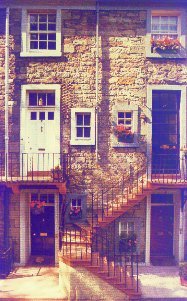
The Old Town of Edinburgh.
 The Old Town in Edinburgh consists of the remaining section of the medieval city and is mainly clustered along the ridge of the Castlehill and the immediate south. The heart of the Old Town is, of course, the Royal Mile - the road which runs from the Castle to the Palace of Holyroodhouse. Along it's length this road consists of the Castlehill, the Lawnmarket, the High Street, The Canongate and the Abbey Strand. The remainder of the Old Town is the Grassmarket -a large open space below the Castle to the South- the Cowgate -a street running East from the Grassmarket, parallel to the Royal Mile- and the streets and alleys running off these three centres.
The Old Town in Edinburgh consists of the remaining section of the medieval city and is mainly clustered along the ridge of the Castlehill and the immediate south. The heart of the Old Town is, of course, the Royal Mile - the road which runs from the Castle to the Palace of Holyroodhouse. Along it's length this road consists of the Castlehill, the Lawnmarket, the High Street, The Canongate and the Abbey Strand. The remainder of the Old Town is the Grassmarket -a large open space below the Castle to the South- the Cowgate -a street running East from the Grassmarket, parallel to the Royal Mile- and the streets and alleys running off these three centres.
The Royal Mile is best visited by starting from the castle Esplanade and walking downhill. The Castlehill section may be short but it is full of interest, it begins with Cannonball house with the (fairly) new tourism centre opposite. The building housing the centre was for many centuries a large water tank supplying the Old town and the cannonball in the wall of the house opposite is supposed to have marked the level of the springs at Comiston to the south which were the source of Edinburgh's first piped water supply.
 Behind the Tourism centre lies Ramsey Gardens, a picturesque group of buildings that have appeared on more postcards than you might believe possible. These properties include "Goose-pie House", an octagonal building which was the home of the eighteenth century poet Alan Ramsay.
Behind the Tourism centre lies Ramsey Gardens, a picturesque group of buildings that have appeared on more postcards than you might believe possible. These properties include "Goose-pie House", an octagonal building which was the home of the eighteenth century poet Alan Ramsay.
Also in the Castlehill are the Scotch Whisky Heritage Centre, the Outlook Tower and the Highland Tolbooth. The Outlook Tower has a Camera Obscura at its top, which by a system of mirrors and lenses projects an image of the city onto a table whilst a running commentary offers a detailed tour without moving from one's seat. The Highland Tolbooth is the impressive Victorian Gothic ex-church at the foot of the castlehill which is due to be turned into a Festival centre with ticket sales, press facilities, exhibition space and a Festival club.
The Lawnmarket is the next section, but if you hope to buy some green stuff for the front of your house this is the wrong place to come - "Lawn" refers to the linen once sold here. One of the highlights here is Gladstone's Land, an old building which has been restored and furnished to show how a well-to-do merchant lived in 17th. Century Edinburgh, the painted chamber with decorated wooden ceiling and walls is particularly impressive. Close by is the entrance to Lady Stair's Close, which is well worth a look itself and is the site of the Lady Stair's House which celebrates Sir Walter Scott, Robert Burns and R. L. Stevenson.
Speaking of Stevenson, off the other side of the Lawnmarket lies Brodie's close - named after the father of the Deacon Brodie who is said to have inspired the famous "Dr. Jekyll and Mr. Hyde". Deacon Brodie is also remembered by a local pub named after him, situated at the corner of the Lawnmarket and Bank Street. As an aside there is another pub in the Lawnmarket - the Ensign Ewart - which deserves to be noted in history, it was the first pub I was ever served in! (and definitely not the last). I have thought about requesting a Commemerative plaque, but there might be awkward questions asked about my age at the time.
The High Street is the third section, this is dominated by the High Kirk of St. Giles on one side and the City Chambers on the other. The City Chambers house the offices where our Glorious rulers (in their opinion) do whatever it is they do when they are not junketing around at the tax-payers expense - their other main occupation seems to be dreaming up insane traffic plans to annoy the poor fools who have to drive around Edinburgh.








 The Old Town in Edinburgh consists of the remaining section of the medieval city and is mainly clustered along the ridge of the Castlehill and the immediate south. The heart of the Old Town is, of course, the Royal Mile - the road which runs from the Castle to the Palace of Holyroodhouse. Along it's length this road consists of the Castlehill, the Lawnmarket, the High Street, The Canongate and the Abbey Strand. The remainder of the Old Town is the Grassmarket -a large open space below the Castle to the South- the Cowgate -a street running East from the Grassmarket, parallel to the Royal Mile- and the streets and alleys running off these three centres.
The Old Town in Edinburgh consists of the remaining section of the medieval city and is mainly clustered along the ridge of the Castlehill and the immediate south. The heart of the Old Town is, of course, the Royal Mile - the road which runs from the Castle to the Palace of Holyroodhouse. Along it's length this road consists of the Castlehill, the Lawnmarket, the High Street, The Canongate and the Abbey Strand. The remainder of the Old Town is the Grassmarket -a large open space below the Castle to the South- the Cowgate -a street running East from the Grassmarket, parallel to the Royal Mile- and the streets and alleys running off these three centres. Behind the Tourism centre lies Ramsey Gardens, a picturesque group of buildings that have appeared on more postcards than you might believe possible. These properties include "Goose-pie House", an octagonal building which was the home of the eighteenth century poet Alan Ramsay.
Behind the Tourism centre lies Ramsey Gardens, a picturesque group of buildings that have appeared on more postcards than you might believe possible. These properties include "Goose-pie House", an octagonal building which was the home of the eighteenth century poet Alan Ramsay.


